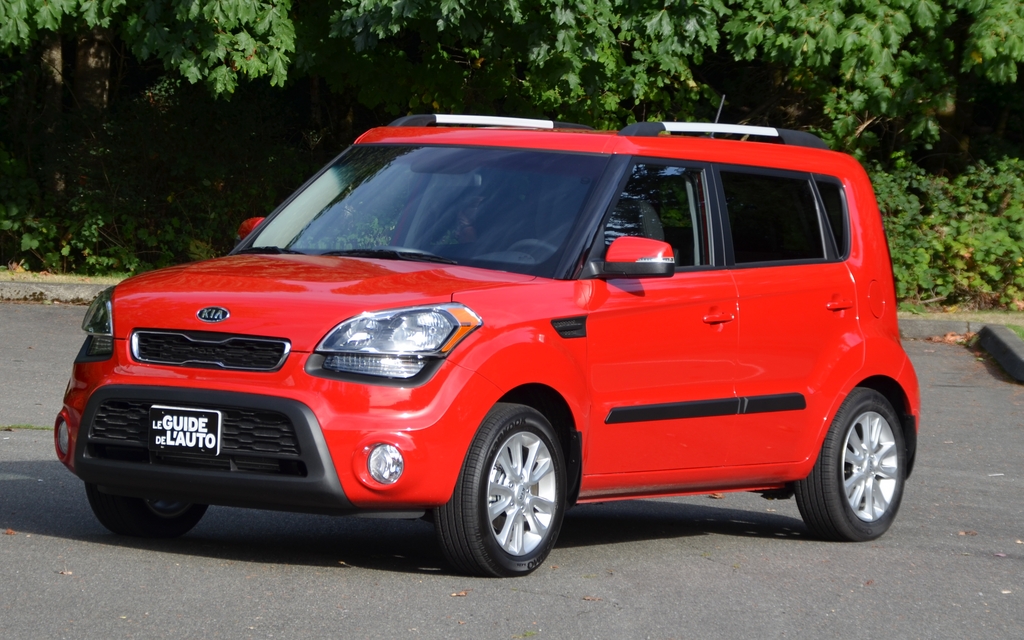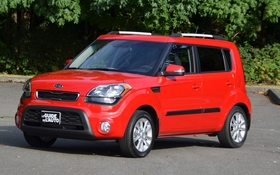2012 Kia Soul: New, but not too new

| Strong points |
|
|---|---|
| Weak points |
|
When Kia unveiled its Soul in 2009, it was a breath of fresh air in the automobile industry. For once, a unique vehicle didn’t go too far. The Nissan Cube (and, later, the Juke) or the Scion xB pushed the envelope a little too far – and they continue to do so, which doesn’t help sales. And yet, the Kia Soul is surprisingly low-key while featuring lines that are just flashy enough.
But time is a cruel mistress and it has started to take its toll on the Soul. Kia has just unveiled an updated version of its crossover, featuring a modest style changes. At the front end, the changes mainly affect the headlights, but tweaks were also made to the bumper, hood and rearview mirrors. The changes are a lot more subtle in the back and in the passenger compartment where the gauges, the central section of the dashboard and a part of the console were only slightly restyled. Kia has been rather vocal about the LED lights in front and in the rear, but you’ll have to choose the more expensive trim to get them. For truly in-depth changes, you’ll have to wait for the second generation of the Soul.
Slightly better equipped to take on life’s challenges
The most significant modifications that Kia made to the Soul are under the hood. Gone are the 1.6-litre weakling and the slightly-less-weak 2.0-litre. Ditto for the four-speed automatic gearboxes and the five-speed manual. Welcome to six-speed transmissions!
For these mid-stream changes, the Soul now calls on two engines that, ironically, possess the same capacity as before. But, capacity notwithstanding, all the rest is different. For starters, there’s a 1.6-litre four-cylinder Gamma engine featuring 138 horses and 123 lbs-ft of torque. According to Kia, this engine should consume 7.4 litres per 100 km in town and 5.6 on the highway. It’s only offered in the base version (1.6L) and its main appeal is its $16,595 base price. Soon, some 1.6-litre Souls will be equipped with the ISG technology that helps put the engine on standby when the vehicle is stopped (i.e. at red lights). That’s great news, but until now this type of technology has needed conditions to be nearly perfect (exterior temperature between such and such, engine temperature, transmission temperature, using the air conditioning or heating, etc.), so it’s very rare that the engine really stops. We’ll see...
The 2.0-litre is best
The 2.0-litre will definitely be the more popular engine. Derived from the 1.8-litre that equips, among others, the Hyundai Elantra, this engine develops 164 horses and 148 lbs-ft of torque which, on paper, guarantees respectable performances for the Soul, which weighs in at 1,353 kilos for the most posh version,. However, my colleague Nadine and I were never able to take it from 0-100 km/hr in under 11 seconds; that’s within a few tenths of a second of the less powerful (142 horses) old two-litre’s numbers. More thorough testing is needed, but the automatic gearbox may be to blame since it’s clearly selected more for fuel economy than for performance. What’s more, there’s an Active Eco mode that, once activated, improves economy and reduces performance. Speaking of fuel economy, Kia posts 7.9 in town and 5.9 on the highway for the automatic and 7.9 and 5.8 for the manual.
Let’s talk about the manual. I wasn’t impressed by the Rio’s new manual transmission, and I was even more disappointed with that of the Soul. How can you create such soft clutches and such imprecise stick shifts? Kia must have hired its engineers from Yoplait.
However, when equipped with a 2.0-litre engine, this Soul turn is much more pleasant to drive than previous models – and they were nothing to sneeze at! The 4u trims’ suspensions are definitely much sportier and firmer (perhaps too firm for some), and they generally strike a good balance between handling and comfort. The 4u name refers to the vehicle’s equipment level and not to the number of drive wheels – two in front, for the record. The steering is precise and provides some feedback, while the brakes are respectable in normal conditions.
Are you UVO or GPS?
Life is easy on the inside. There are several storage spaces, the controls are well situated and some versions feature the UVO system developed in collaboration with Microsoft. This system is a bit like Ford Sync, but I was careful not to waste time trying to figure it out during the short time that I had to test the car, as I’m hopeless when it comes to gizmos like this. So I can’t say whether it’s easy to use or not. My time was better spent reading the press document, where I learned that if you have the UVO system, you can’t order the navigation system.
When it first launched, the Soul was well-bred. Today, it’s aging well, and the modifications that Kia has made will help it stand the test of time, at least until the next generation arrives.











